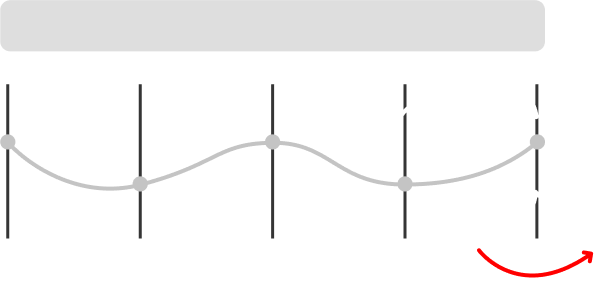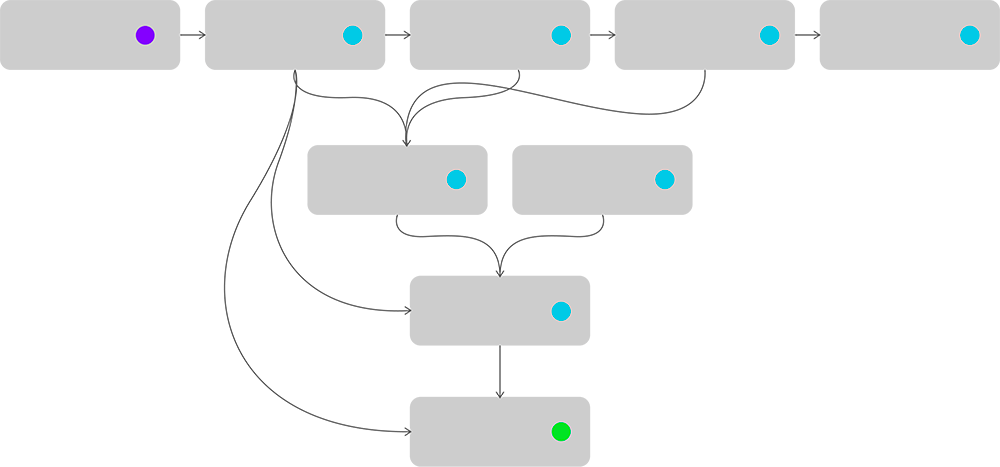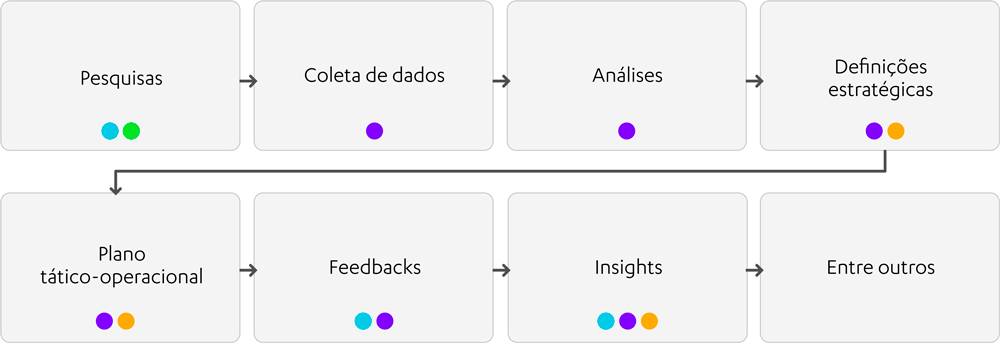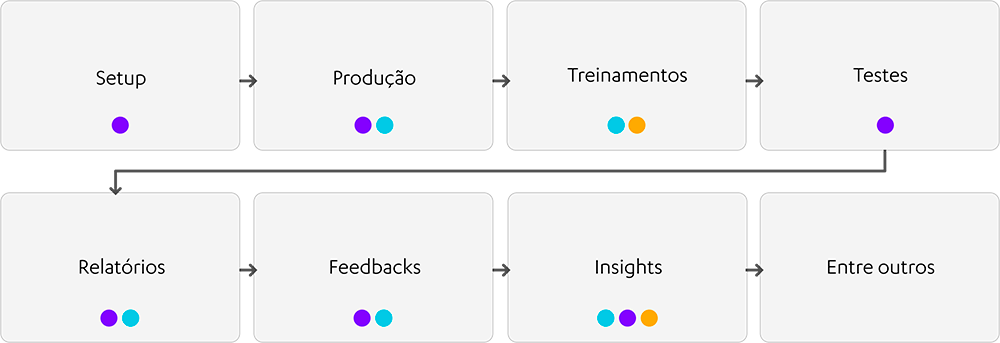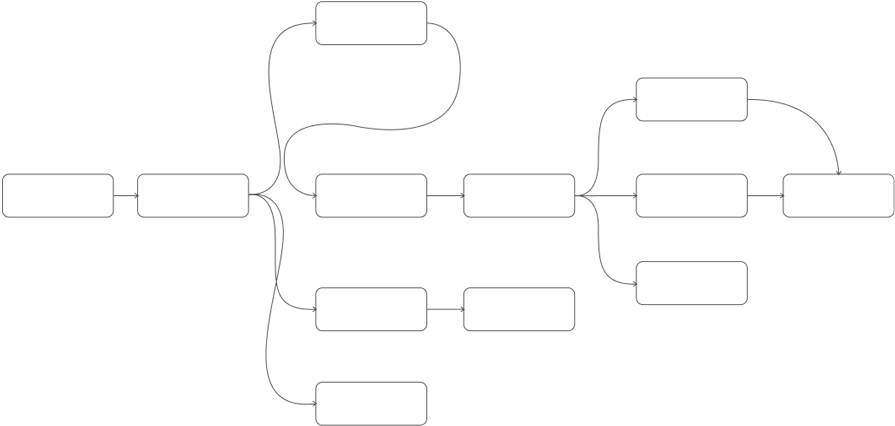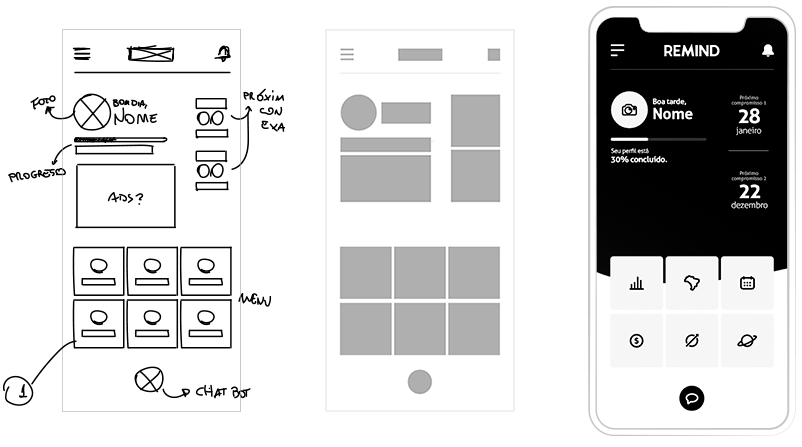What is it?
The brand needs to work for those who make it and for those who use it.
For those who do it: your team and everyone who speaks on behalf of the brand.
For those who use it: your client and everyone who has contact with it.
Creating the ideal user journey is done by analyzing usage and satisfaction data, market references and constant feedback with customers, users and internal staff.
Everything so that the experience of everyone involved is truly positive, functional and facilitating at all points of contact.
What is it for?
It serves to facilitate everything possible. JIU operates throughout the entire sales, purchase, use and support journey, from beginning to end.
1. Understand the current scenario.
2. Defines the product or service experience.
3. Activates the teams responsible for final delivery.
4. Creates an easily replicable process for the internal team.
5. Activates a relevant and facilitating product for the end user.
1. Definitions
It is the starting point for mapping to understand how everything happens, inside and outside the company.
Product or service?
Differential
Operating channels
Involved areas
Understanding the operating model of the product or service offered (digital, physical, seasonal, recurring, etc.) and what it does in practice. Based on this, the optimal journey is chosen.
Validation of what differentiates you from the competition, so that it is possible to strategically value value at all possible stages of the customer connection journey.
Mapping the channels where the product is active (online or offline) and directing the ideal plan, taking into account the strategy adopted and the particularities of each one.
Involvement of product creation and delivery teams, for validations, research and testing of the current brand experience.
Ex.:
• Commercial marketing
• Technology
• Operation
2. Acting days
Far beyond understanding the brand, product or service, we visualize the step-by-step implementation and delivery, to know exactly what works and what doesn't. This way, it is possible to build a specific and segmented journey based on what really makes a difference.
As a concept without practice becomes a discourse, so we separated a real case to explain the details of this entire journey mapped and created for a company specializing in customer service.
* Confidential data, numbers and strategies were not included here for ethical reasons.
* Each sector or company has a specific need.
* Generic productions do not solve problems.
2.1. Prospection
Among all the possibilities for communication, positioning, activation of partnerships and market gaps, we chose those that made the most sense according to the product and target audience. Thus, we created an active line of communication to generate brand value for users from the knowledge and sales phase to post-sales and day-to-day relationships.
Prospecting materials
The choice of channel serves as a basis, what actually connects both ends (brand and customer) is the right activation, at the right time and with the exact content.
Sales pitch with visual customization for each prospect.
Simplified, explanatory and unique commercial proposal for each client.
Launch campaign and valorization of existing products.
Communication planning and themes for the press office.
It was what made sense for them and accelerated the deal with the biggest retail and fashion brands in the country.
Prospect Journey
Generating value at each stage, from sale to final delivery, was what allowed accelerated growth.
We provide strategic insights for the prospect's entire evolution journey, aiming to facilitate understanding processes with mockups and MVP's, from moment zero to the moment of repurchase.
2.2. Immersion
Immersion is a process that makes a difference in the perception of value and recognition of quality.
When selling: we adapt verbal and visual language to attract attention.
In post-sales: we direct everything that could be evaluated towards customer development.
2.3. Implementation
The implementation of all this is only possible with the involvement of all teams, leaders and those responsible for deliveries. So that there is full understanding, interconnection of teams, generation of new ideas, tests and practical validations of the ideal user journey.
2.4. Operation
After the immersion and implementation is complete, it’s time to put everything into the air with those on the front line. This is where the process shows results.
But none of this is left to guess, much less in the minds of those who do it. This is documented so that any current or new team member knows where to start and what to do in a simple way.
2.5. Reports and Insights
Each case requires a specific focus, in this example a process of approaching the end customer was necessary to evolve the partnership and sell new services. We created a standard of constant reports and insights so that he knew the status, next steps and general performance of the service.
3. User Experience
After detailing internal processes, let's move on to the external, that is: practical delivery to the consumer.
In this example, in addition to the operating channels, we recreated the entire experiential journey of the product and the ideal interface so that the user has the best possible experience.
Thinking about all the ends is the only way to a positive experience.
The idea of providing it makes the user's life easier in every way possible, until they actually feel like they are an important part of your business.
And whoever belongs, stays.




